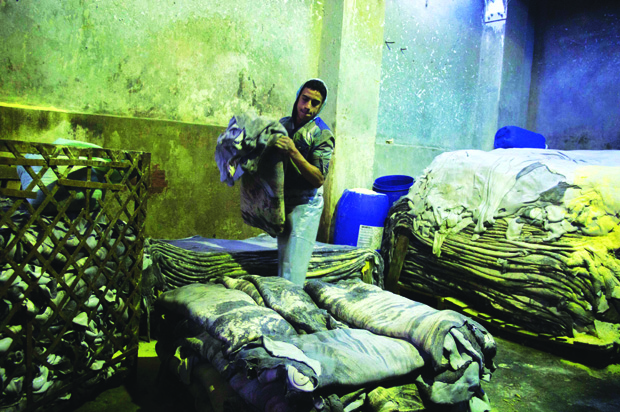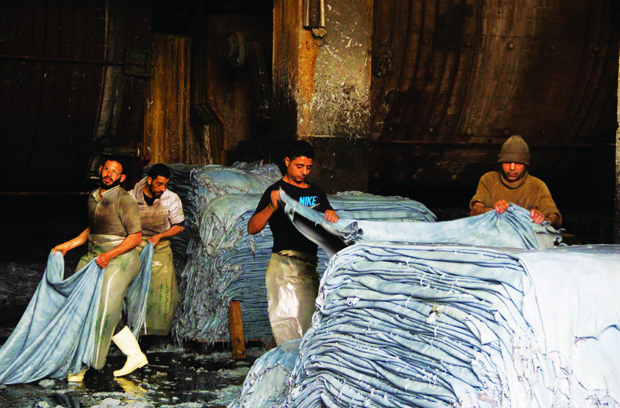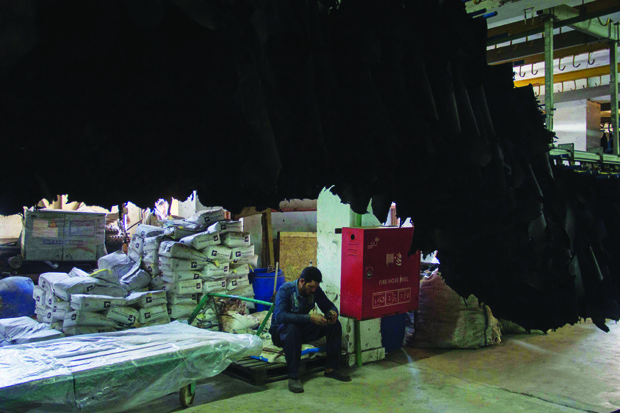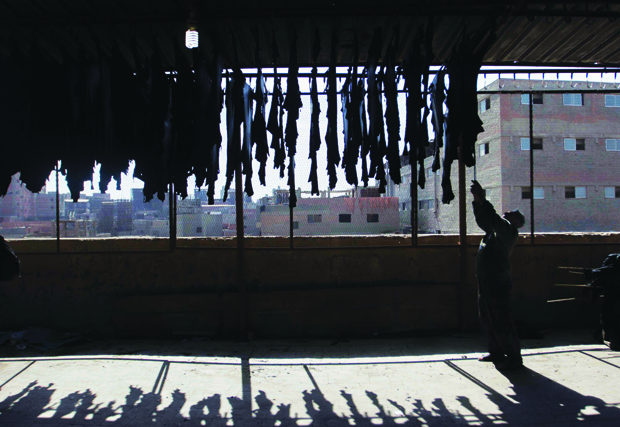As the capital’s leather tannery workers await news of an imminent relocation outside the city, the workmen who have dedicated their lives to the once-booming trade are concerned a hold on exports will choke their industry to death.
written and photographed by Abdelrhman Mohamed
For centuries the nation’s leather tanneries have been nestled in Sur Magra El-Oyoun in the heart of Old Cairo. Egypt has a long history of tannery, an industry that brings in billions of dollars every year. But a government decision to transfer the workshops outside of Cairo will, many feel, signal the end of a successful industry.
[caption id="attachment_504622" align="alignnone" width="620"] A worker stacks hides before they are cleaned of hairs.[/caption]
A worker stacks hides before they are cleaned of hairs.[/caption]
The government’s plan to relocate tanneries to Rubeiky in Badr City, 40km outside the capital, is not a new one. Meeting with vehement protests from the workers themselves, who feel they will be exiled away from their homes, the plan has been shelved several times in past years. But with Old Cairo suffering from neglect by authorities, tannery employees themselves can no longer work under the ever-worsening conditions and today many are calling on the government to put the proposed plan into action.
[caption id="attachment_504623" align="alignnone" width="620"] These barrels use chemicals to clean the hides that are being tanned.[/caption]
These barrels use chemicals to clean the hides that are being tanned.[/caption]
But it wasn’t just the resistance holding back the government from going ahead with the relocation: a lack of funding makes it difficult to kickstart the process. Last March, Minister of Trade and Industry Tarek Qabil announced that the relocation is set to finally go ahead as planned and that the government will begin signing over workshops in July.
A day following the announcement, El-Watan published an investigative piece assessing how ready the residential area surrounding the factory sites was to receive its incoming tenants, finding that it was not yet as habitable as authorities would have leather tannery workers believe. There is still work to be done in the residential areas, primarily the paving of the four-kilometer long road connecting Rubeiky with the main thoroughfare, lighting and putting a police force in place to ensure security.
[caption id="attachment_504624" align="alignnone" width="620"] The hides are hosed down with water and then stacked to get rid of the excess water.[/caption]
The hides are hosed down with water and then stacked to get rid of the excess water.[/caption]
Reactions to the relocation announcement have been mixed. “Many of the owners want to go. Right now we’re suffering from ever-worsening conditions here: deteriorating facilities like piling garbage and lack of hygiene, and frequent gas and electricity cuts. So many of us have asthma, and moving to a less polluted area like Badr will be beneficial to us all.”
[caption id="attachment_504626" align="alignnone" width="620"] A worker takes a break under the dyed hides.[/caption]
A worker takes a break under the dyed hides.[/caption]
On location in Badr, El-Watan spoke to Tamer El-Nems, an engineer and member of the Badr City Youth Council. “The site is one of the most ideal for a tannery industry due to the strategic location within the Badr industrial complex,” El-Nems says. “This is in addition to its proximity to the Ring Road and the Cairo-Suez Road, which are ideal for transporting goods to ports in the Red Sea for export.”
[caption id="attachment_504627" align="alignnone" width="620"] A worker feeds the tanned hides into a machine for extra color.[/caption]
A worker feeds the tanned hides into a machine for extra color.[/caption]
But not everyone is as welcoming, arguing that the relocation will only mean them losing their loyal customers in Old Cairo, many of whom they know personally. “It won’t be easy after so many years in Magra El-Oyoun to move out. But if the decision is going to be applied to all, I will go – as long as the place that I am being moved to is better than or at least as good as the place I’m in now. There has to be compensation,” workshop owner Ahmed Mahran told El-Watan. “But we’ve been hearing about the plan for years. Now we’re in March and they say we’re being moved in July and no one has even informed us of the decision. There are around 100,000 of us working the tanneries, and no one’s been told,” Mahran complains.
Abdel Rahman El-Gabbas, a member of the Leather Tanning Chamber, disclosed to El-Watan that once the Rubeiky facilities are completed in July, the first phase of relocation will be announced by the Ministry of Trade and Industry and that relocation would begin straight away. “Those who want to move will be able to present their applications in July and those who don’t will be offered compensation of LE 2310 per meter. Workshop owners who decide to move will be given a workshop with a hangar.”
[caption id="attachment_504628" align="alignnone" width="620"] A worker hangs leather hides in the sun to dry out.[/caption]
A worker hangs leather hides in the sun to dry out.[/caption]
Workshop owners have asked for nearby housing for their workers in addition to infrastructure facilities, such as sewage systems, electricity and water.
In the meantime, workshop owners say they have even bigger worries than being moved. “We are concerned about the future of the tannery industry in Egypt, given the hold on exports from Egypt,” says Mahran. “We’ve been forced to bring down our prices and flood the domestic market, hitting each other below the belt. Since 2011, about 90 percent of us have been forced to shut down our shops. A lift on exports is our only chance of survival.”
Comments
Leave a Comment